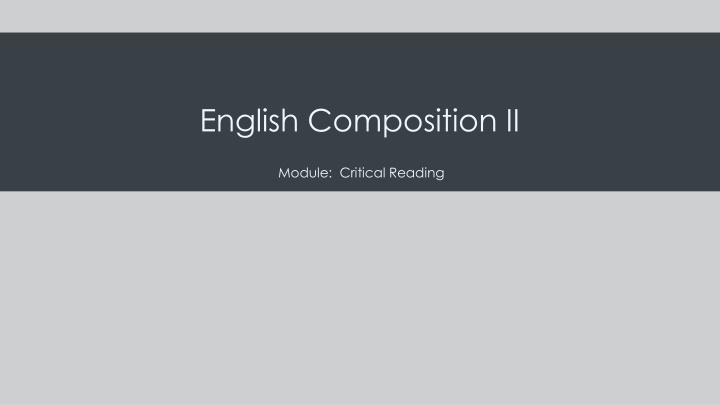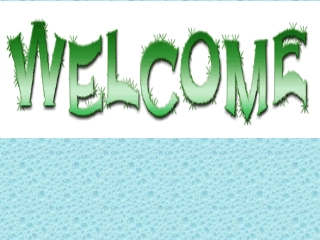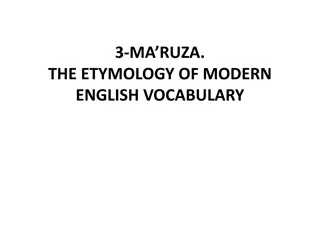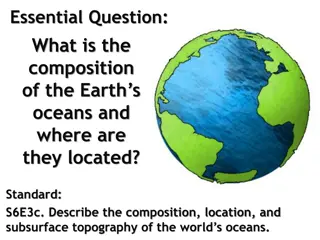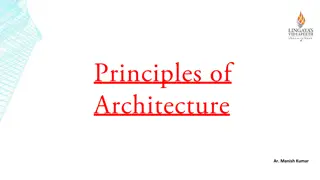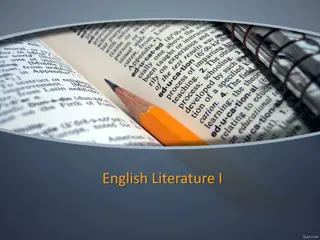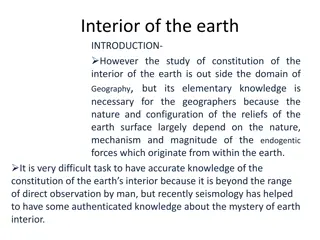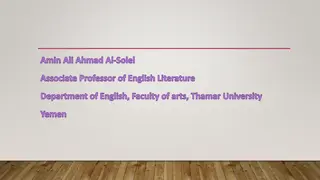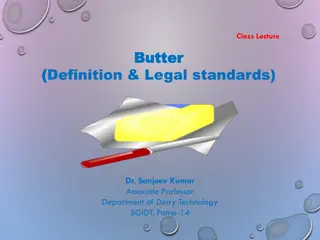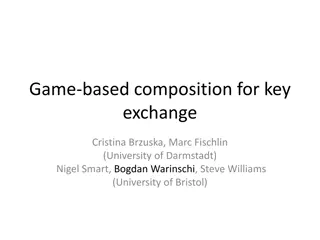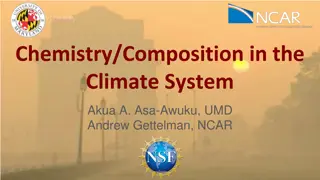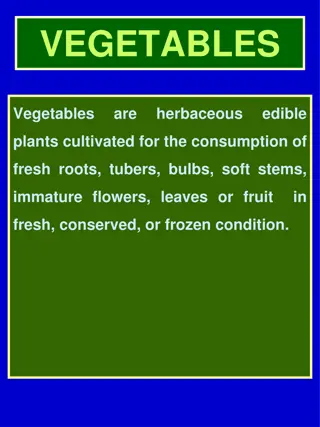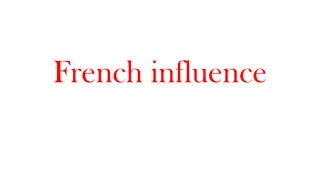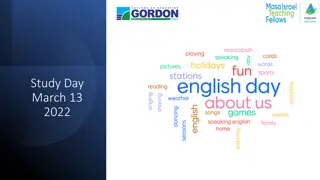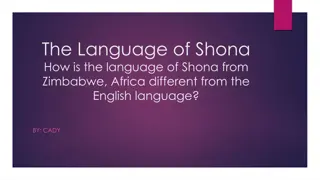English Composition II
Dive into the world of critical reading with a focus on academic contexts. Explore tips for effective reading, the impact of genre conventions, and how to write insightful summaries and critiques. Understand the importance of critical reading in everyday life and academic endeavors. Learn to distinguish between academic and casual reading, identify main ideas, and decipher scholarly articles across disciplines. Enhance your skills in active reading and elevate your academic performance through strategic reading techniques.
Download Presentation

Please find below an Image/Link to download the presentation.
The content on the website is provided AS IS for your information and personal use only. It may not be sold, licensed, or shared on other websites without obtaining consent from the author.If you encounter any issues during the download, it is possible that the publisher has removed the file from their server.
You are allowed to download the files provided on this website for personal or commercial use, subject to the condition that they are used lawfully. All files are the property of their respective owners.
The content on the website is provided AS IS for your information and personal use only. It may not be sold, licensed, or shared on other websites without obtaining consent from the author.
E N D
Presentation Transcript
English Composition II Module: Critical Reading
Learning Outcomes Evaluate strategies to create and interpret academic arguments 3.1: Explain tips for reading effectively in an academic context 3.2: Describe how genre conventions shape and are shaped by writers' practices and readers' expectations 3.3: Write summaries and critiques using analytical strategies and techniques
Why It Matters We use critical reading in everyday life! Reading traffic signs Reading work emails Reviewing details of an upcoming election Understanding doctor s orders Critical reading is like detective work: Look for clues Gather evidence Ask questions Review material Look for patterns
Learning Outcomes: Academic Reading 3.1: Explain tips for reading effectively in an academic context 3.1.1: Recognize differences between casual reading and active academic reading 3.1.2: Identify strategies to read scholarly articles in various disciplines 3.1.3: Identify strategies to read scientific and technical documents 3.1.4: Identify strategies to read charts, graphs, or visual aids
Academic vs. Casual Reading Active Reading Casual Reading Uses pre-reading strategies to understand the argument No pre-reading strategies are required Requires focus and effort. A good environment is key. Can be done anywhere, even with distractions or when tired. Should be broken up into smaller sections because it can be tiring No time constraints because the enjoyment makes it easy Needs more time for vocabulary and difficult sections Context clues are given for unfamiliar words Requires some writing for notes or annotations No writing is required; just open the book and read Reviewing the material directly after reading is necessary No follow up after reading is needed
Active Reading: Identifying the Main Idea Critical reading is necessary to find the main idea. Review the table of contents/chapter headings Titles, headings, and subheadings tell the subject matter Bold, italic, and repeated words are all clues Review visuals and statistics provided Ask questions before, during, and after reading small sections
Reading Scholarly Articles Scholarly articles can be harder to understand or read than everyday articles. Strategies for reading scholarly articles Skim and scan Skim the overall document to see if it fits in with your research Scan for keywords, phrases, and specific information Read the abstract Abstracts will often give the main points and ideas Question and annotate Start with a research question, look for the answer when reading, and make notes as you read IMRaD Format Review the Introduction for background information, the Methods for details about the methodology, the Results for what was found, and the Discussion for explanations, limitations, etc. Read the references Look at the references of an article for further information
Reading Scientific Documents Scientific documents require more time, a varied reading structure, and further research. Steps for reading a primary research article: Read the introduction, not the abstract Identify the main question that the research is seeking to answer Review prior research and summarize the background Be able to state the specific questions being asked
Reading Scientific Documents Continued Identify the approach, or how the scientists plan to answer the question(s) Review the methods section Read the results section and look at visuals, sample size, wording, and if the question was answered Read the discussion or interpretation section, understand it, and see if you still have questions Re-read the abstract and compare it to what was found Review what other researchers have said about the article
Reading Technical Documents Technical documents are usual scientific or mathematical in nature. Strategies for reading technical documents: 1. Recognize and understand the layout, as they will vary 2. Find and review headings 3. Understand the overview of the document 4. Identify and look up any unfamiliar vocabulary 5. Take notes keep them broad rather than specific 6. Review the introduction, abstract, and conclusion first to understand context
Reading Charts, Graphs, and Visual Aids Visual aids include, but aren t limited to: charts, graphs, infographics, audio, video, slide presentations. Scatter plots show data points Line charts show trends Bar graphs compare quantities Pie charts show proportions of a whole
Reading Charts, Graphs, and Visual Aids Questions to ask when reading charts and graphs: What is the topic? What is being measured? How is it being measured? Is it color-coded? Can I summarize this in my own words?
Practice Question 1 What is the main difference between active reading and casual reading? A. Active reading requires more preparation, thought, and focus than casual reading. B. Active reading pertains to scientific documents, whereas casual reading is fictional books. C. Casual reading is fun and entertaining; active reading shouldn t be a fun activity. D. Casual reading can be over any topic, but active reading is limited to specific topics.
Class Activity: Active Reading in Practice In small groups, work with the scholarly article Implications for educational practice of the science of learning and development https://www.tandfonline.com/doi/epub/10.1080/10888691.2018.1537791?need Access=true . Complete the following ten steps. 1. 2. 3. 4. 5. 6. 7. Read the introduction, not the abstract Identify the main question that the research is seeking to answer Review prior research and summarize the background Be able to state the specific questions being asked Identify the approach, or how the scientists plan to answer the question(s) Review the methods section Read the results section and look at visuals, sample size, wording, and if the question was answered Read the discussion or interpretation section, understand it, and see if you still have questions Re-read the abstract and compare it to what was found 10. Review what other researchers have said about the article 8. 9.
Learning Outcomes: Genre and Media 3.2: Describe how genre conventions shape and are shaped by writers' practices and readers' expectations 3.2.1: Differentiate between the goals and purposes of various genres of texts 3.2.2: Analyze characteristics from different genres of text 3.2.3: Distinguish between the ways different media communicate
What is Genre? French in origin meaning type, kind, category, or class Ex: horror, Western, drama, action, comedy, romance, etc. Understanding the genre helps set expectations. A genre represents a pattern or set of rules that a given text follows in order to communicate its message effectively to its intended audience. Purposes of different genres: Textbooks to educate Scholarly articles to show new knowledge or offer a new perspective on existing knowledge Reference works to provide specific details for a current knowledge need Journalism to inform or persuade Literature to entertain and engage the reader.
Identifying The Genre You see all that water? Simon said. That all used to be land, and now it s gone. He pointed in the direction of their house. And one day this ll all be water too. We ll have to get out of here or else we ll drown. Sarat saw the faint smirk on her brother s face and knew instantly he was trying to scare her. She wondered why he seemed so obsessed with such tricks, why he often tried to say things in the hopes of making her react in some fearful and foolish way. He was three years older than she was, and a boy a different species altogether. But still she sensed in her brother a kind of insecurity, as though trying to scare her was not some cruel way to pass the time, but a vital means of proving something to himself. She wondered if all boys were like this, their meanness a self-defense. And anyway, she knew he was a liar. The water would never eat their home. Maybe the rest of Louisiana, maybe the rest of the world, but never their home. Their home would remain on dry land, because that was the way it had always been.
The Medium and the Message The medium is the means by which information is communicated. Ex: Radio, film, print, digital presentation, paint on canvas, fabric, etc. The medium changes the message. A movie creates an emotional reaction through music, visuals, and colors. In a text, emotions are affected through diction, symbolism, and other literary devices.
Practice Question 2 Chapter 44: Ecology and the Biosphere Section 44.5: Climate and the Effects of Global Climate Change By the end of this section, you will be able to do the following: Define global climate change. Summarize the effects of the Industrial Revolution on global atmosphere carbon dioxide concentration. Describe three natural factors affecting long-term global climate. List two or more greenhouse gasses and describe their role in the greenhouse effect. Based on the brief excerpt above, which genre does this belong to? A. Scientific article B. Literature C. Textbook D. Journalism
Class Activity: Putting Genres into Context Individually, spend a few minutes and list 3 or more reasons you write in any given day. Then spend about 5 minutes listing what each reason produces. For instance, if you said texting a friend, your answer here would be a text message. Share your answers in small groups. In those same groups, brainstorm various reasons for writing in an English class, specifically this class. Identify the types of writing that would result from these reasons. For example, in a chemistry class, a reason to write would be to show lab results, and the type of writing (or genre) that would be produced is a lab report.
Learning Outcomes: Summary and Analysis 3.3: Write summaries and critiques using analytical strategies and techniques 3.3.1: List strategies and techniques for summarizing a text 3.3.2: Recognize the difference between summary and analysis 3.3.3: Use rhetorical analysis to critique a text's voice, audience, and purpose 3.3.4: Identify strategies and techniques for critical analysis of a text
Summary vs. Analysis Summaries condense material while keeping the original meaning Can be long or short Avoid point by point style Keep in line with original text Analysis breaks down material to figure out how it works. Break down information into parts Uncover relationships within those parts Determine motives and causes Make inferences Active Reading Summary: write keywords in margins, identify thesis & topic sentences, label lists Analysis: Identify issues with the argument, connections to other texts, and ask questions in the margins
Summary vs. Analysis Summary Analysis No argument or claim about text Makes an argument or claim about text Portrays main ideas of text Breaks down text based on the needs of the argument Limited discussion or interpretation, if any Discussion and interpretation is key No judgments about the text Judgments are allowed Tone should be neutral and declarative Editorial intervention and signal phrases are needed
Rhetorical Analysis Rhetoric refers to the art of persuasion. Rhetorical means persuading or making a point. A rhetorical analysis should ask the purpose behind a text. Who is the intended audience? Why was the text written? What is the situation presented? What is the overall message? How is the author portraying that message?
Critical Analysis Very similar to rhetorical analysis Main difference is the starting point Critical analysis starts from the text itself a close reading Close Reading Develop a deeper understanding of the text Slow down Don t go immediately to the thesis Annotate: write in the margins, underline, highlight, etc. Take note of interesting ideas and new vocabulary Get specific Look at specific words what is interesting? What is new? What patterns recur? Identify contrasts or opposites that are presented.
Practice Question 3 The following is a summary that Ricardo wrote on a selection of an autobiography of his favorite fighter, BJ Penn. Penn wasn t supposed to become a fighter. It was never his dream. He said, I did not plan to be a fighter; one thing just happened after another. Before I knew it, I was standing behind a curtain waiting to walk out to fight Joey Gilbert. Maybe I made some questionable decisions before I arrived at that point, but I also made a lot of good ones (Penn, p. 14). His entry into fighting wasn t intentional. What is the biggest problem with this summary? A. Ricardo doesn t introduce the topic well. B. The main ideas isn t presented strongly. C. The tone is not neutral. D. The majority of the summary is a quote.
Class Activity: Summary and Analysis Practice In a small group, brainstorm a book you ve all read or a movie or show you ve all seen (ideally recently). Though it is lengthy, summarize it in no more than 2 paragraphs (5-7 sentences each). After you summarize, share the summaries in small groups. Is there information that a peer had that you didn t? Did you include information that wasn t necessary? Next, consider the text again, but this time, consider it through the lens of analysis. How does your interpretation/understanding change? What details stand out through analysis that didn t through summary?
Quick Review Active reading requires time, focus, and effort. Scholarly articles can be reviewed using skimming, scanning, questioning, annotating, reading the abstract and references. Scientific papers strategies are reading the sections out of order, taking notes, reading multiple times, and doing further research. Technical documents are scientific or mathematical in nature. Visual data, such as charts or graphs, are helpful. A genre is a pattern or set of rules for each text. Medium is how a message is portrayed. Summarizing should be in your own words, preserving the meaning. Analyzing should break down the information. Rhetorical analysis asks what purpose the text is trying to achieve. Critical analysis and close readings focus on the text itself, looking for details and patterns.
